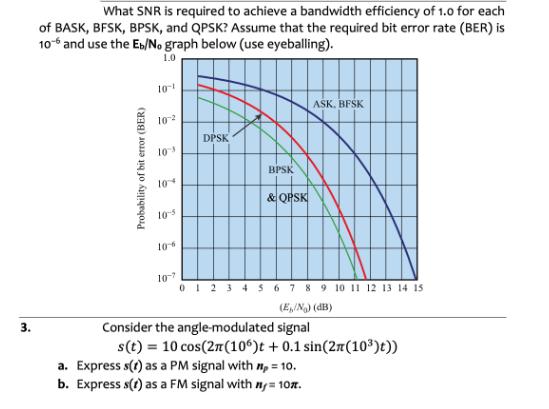Answered step by step
Verified Expert Solution
Question
1 Approved Answer
3. What SNR is required to achieve a bandwidth efficiency of 1.0 for each of BASK, BFSK, BPSK, and QPSK? Assume that the required

3. What SNR is required to achieve a bandwidth efficiency of 1.0 for each of BASK, BFSK, BPSK, and QPSK? Assume that the required bit error rate (BER) is 106 and use the Eb/No graph below (use eyeballing). 1.0 Probability of bit error (BER) 10-1 10-2 10-5 10+ 10-5 10-6 DPSK BPSK & QPSK ASK. BFSK 10-7 0 1 2 3 4 5 6 7 8 9 10 11 12 13 14 15 (E/N) (dB) Consider the angle-modulated signal s(t) = 10 cos(2 (106)t + 0.1 sin(2n(10)t)) a. Express s(t) as a PM signal with = 10. b. Express s(r) as a FM signal with ny = 10%. 3. What SNR is required to achieve a bandwidth efficiency of 1.0 for each of BASK, BFSK, BPSK, and QPSK? Assume that the required bit error rate (BER) is 106 and use the Eb/No graph below (use eyeballing). 1.0 Probability of bit error (BER) 10-1 10-2 10-5 10+ 10-5 10-6 DPSK BPSK & QPSK ASK. BFSK 10-7 0 1 2 3 4 5 6 7 8 9 10 11 12 13 14 15 (E/N) (dB) Consider the angle-modulated signal s(t) = 10 cos(2 (106)t + 0.1 sin(2n(10)t)) a. Express s(t) as a PM signal with = 10. b. Express s(r) as a FM signal with ny = 10%.
Step by Step Solution
★★★★★
3.46 Rating (153 Votes )
There are 3 Steps involved in it
Step: 1
2 Let us consider R rate of data B bandwidth So we have RB 10 g...
Get Instant Access to Expert-Tailored Solutions
See step-by-step solutions with expert insights and AI powered tools for academic success
Step: 2

Step: 3

Ace Your Homework with AI
Get the answers you need in no time with our AI-driven, step-by-step assistance
Get Started


